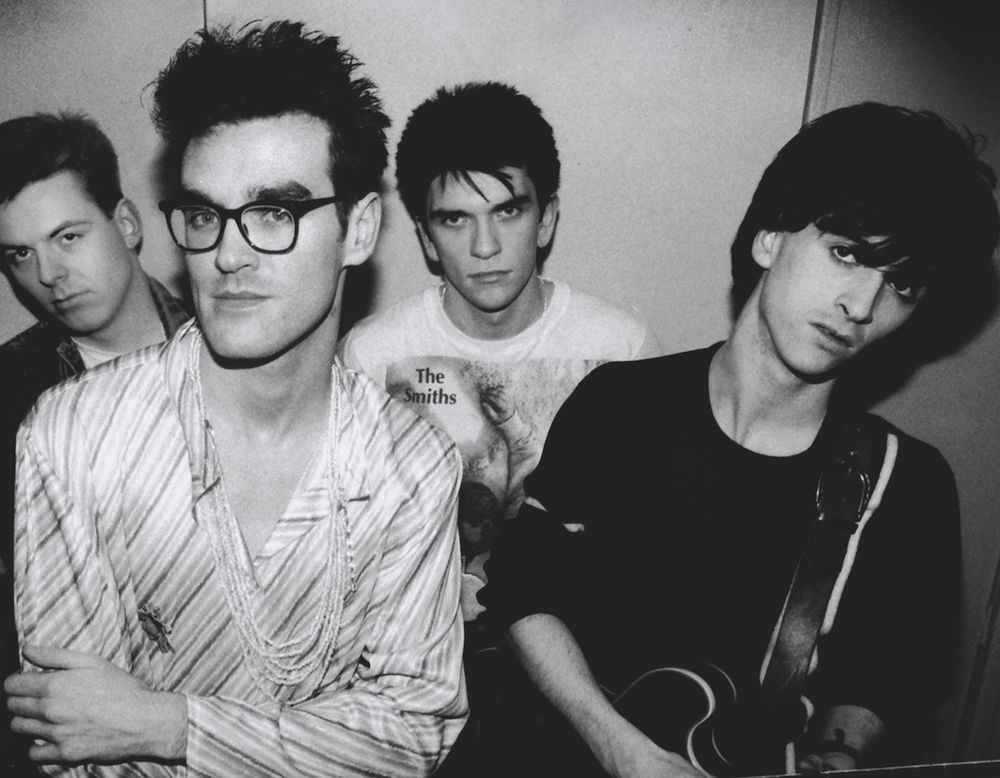Everyone always talks about the death of rock 'n' roll, but in retrospect, the Cramps were the only artists doing anything to resurrect it. Filth. Sleaze. Shock. Flesh. Fetish. These were the quartet's tactics. Frontman Lux Interior writhed around on stage, searching for a new kind of kick and screaming about eyeballs in martinis, a lubed-up serpent mutant hissing and howling at fans — his leather pants miraculously gone. Meanwhile, guitarist Poison Ivy would keep the pace with her sinuous blues riffs clad in pin-up or dominatrix wear. She was the lion tamer to Interior's ferocious beast.
Despite a variety of lineups, for three decades their mission was always the same: to disrupt and debauch audiences like the first rock 'n' roll records did in the '50s. "It's become respectable," Ivy said in an interview about the then current state of rock 'n' roll. "And that's where the death of rock 'n' roll is, in respectability. It should be music for misfits. It should be dangerous," she continued. "The purpose of rock 'n' roll is instant gratification."
Bonding over their love of the demented and disgusting, the Cramps began and finished as a love story. The group's core duo Erick Purkhiser (aka Lux Interior) and Kristy Wallace (aka Poison Ivy) met in 1972 when the former picked up the latter as a hitchhiker. Weeks later, it happened that they both were enrolled in an Arts and Shamanism class. Sparks flew, and the two moved in together, encouraging their shared love of crate-digging for old rockabilly records, sexploitation films, and horror b-movies. Within less than a decade, the Cramps were formed, their first official lineup including guitarist Bryan Gregory and drummer Nick Knox.
Although CBGBs' history is filled with more famous groups — the Ramones, Blondie, Television, and the Talking Heads among them — the Cramps were scene mainstays. One of the venue's most unforgettable nights was when the then-unsigned quartet performed under the name Frank Furter And The Hot Dogs. Decades later, Henry Rollins dubbed them "one of the best live bands ever." The Cramps solidified their stance in punk history as the pioneers of psychobilly — a concoction of twangy rhythm and blues, garage rock, and rockabilly. Interior and Ivy pursued their perverse rock 'n' roll lifestyle all the way up until Purkhiser's death in 2009.
The Cramps sound pushed the rock 'n' roll's beginning past the fringes. Dueling guitars and a stark, primitive drumbeat is the ominous, heart-thumping backdrop to Interior's deviant howls. "I'm a vampire. I'm 164 years old," Lux Interior once joked(?). "So I've been around, and I'll tell you right now that the '50s was the height of culture in the Western world." Screamin' Jay Hawkins, Link Wray, Ricky Nelson, Elvis, Duane Eddy, Dick Dale, and Peggy Jones were only some of the influences they consistently paid homage to. The moral panic and beginnings of b-horror movies were even more reasons to admire that period. Oral sex and bondage were on par with werewolves and zombies. There was no topic too taboo and no place that couldn't act as a venue. They notoriously performed at a mental hospital in Napa, California.
https://youtube.com/watch?v=Fat2rswNJ1k
Although beloved by the weirdos and the freaks, the group never reached mainstream fame with their horror-infused horniness. However, they did have a handful of mainstream cameos. They appeared in an episode of 90210 as themselves, and Lux Interior fronted a fictional bird band in a Spongebob Squarepants episode. Even William Shatner covered one of their songs. Now, over a decade after the ghoulish group's end, a viral scene from Tim Burton's Wednesday is spotlighting the Cramps for a new generation.
It was a pleasant macabre surprise when their 1980 single "Goo Goo Muck" soundtracked one of the most entrancing moments in the Netflix series inspired by the beloved Addams Family character. Jenna Ortega, who phenomenally plays Wednesday, choreographed a perfect balance of angular, coordinated punches and wild bursts of thrashing limbs. Possessed, she embodies Poison Ivy's flirtatious precision and Lux Interior's spellbinding madness. It's unfortunate the band is getting its due without Lux Interior and Bryan Gregory alive to witness the current spread of their debauchery. But like true rock 'n' roll, the Cramps' spirit will never die, only rear its ugly head again eager to corrupt those hungry for hedonism.
"Lonesome Town" (from ...Off The Bone, 1983)
Most Cramps songs don't dip below 100 BPM. The weepy exception is their cover of "Lonesome Town," a Baker Knight song made famous in the '50s by Ricky Nelson. In Nelson's version, plush vocals accompanied by romantic backing harmonies make the devastating song sound dreamy. I mean, "You can buy a dream or two/ To last you all through the years/ And the only price you pay/ Is a heart full of tears," is not only incredibly depressing, but loaded with capitalistic delusion. While Nelson's wistful version is a cloud slowly floating off into the stratosphere, the Cramps' rendition is a final trip through the heart's pumping ventricles before the walls collapse from heartbreak. Nick Knox's bass drum delivers a sturdy resting heartbeat; Poison Ivy's guitar strums add structure with reverb adding a teary tinge; Gregory's guitar whines are more avant-garde; it almost sounds like his strings are popping off his instrument. Interior's vocals tie the whole viscerally sad ballad together, mimicking the honeyed delivery reminiscent of the gel-haired sock-hop crooners. Known for his electrocuting vocals, it's surprising to hear Interior this subdued and dreamy. But that doesn't hold him back from performative flare; he begins to weep, gasping for air while he stifles his tears. Psychobillies have feelings too.
"The Way I Walk" (from ...Off The Bone, 1983)
The Cramps were crate-diggers with a gravedigger's aesthetic. Lux Interior and Poison Ivy's relationship was rooted in their love of early rock 'n' roll, which a lot of the world had moved on from, especially in the '80s as the genre barreled towards hair metal. The Cramps were archivists of rock's pioneers, resurrecting forgotten classics like Jack Scott's "The Way I Walk." (One of their major influencers, rockabilly revivalist Robert Gordon, also did a cover.) Scott was a Canadian-American musician and one of the first known figures in the '50s rockabilly scene, rivaling Elvis and Roy Orbison. As with most great covers by the Cramps, the quartet infect "The Way I Walk" with more sexual aggression and rebellion. Interior adds a nasally quiver and growl to certain words; Ivy's grumbling guitar prowl replaces Scott's hollowbody guitar strums; Knox's drum-pounding mimics the feverish heart rate of an erotic prowl. Additionally, the Cramps add shrill screams to their rendition that play both into the horror and horniness of their style. Alongside its heavy emphasis on sexual desire ("Touch me baby, it feels so good/ Sometimes I think I wanna but I don't know if I should"), this cover also acts as the group's accepting mission statement to be freaky, weird, and free as can be. Like it or not, that's just the way they walk.
"Sunglasses After Dark" (from Songs The Lord Taught Us, 1980)
This deep cut from the Cramps' debut album Songs The Lord Taught Us immediately arrests your attention with the opening distorted guitar meltdown that sounds like a rat combusting after getting wrapped in electrical wires. One saw-toothed guitar consistently drones throughout the track while the other engages in a call-and-response with Interior's enraged howls about dawning shades at night. The guitar craftsmanship alone on "Sunglasses After Dark" could have easily been the reason for making this list. But the reason this one beats out their covers of the Sonics' "Strychnine" and Eddie Cooley and Otis Blackwell's "Fever" (made famous by Peggy Lee), the unsettling serial killer anthem "TV Set," and the few other gems on their debut, is the way "Sunglasses After Dark" innovatively reinvents the group's influences. "Sunglasses After Dark" interpolates Link Wray's famous pin-picking guitar riff from "Ace Of Spades" and lyrics from Dwight Pullen's 1958 single of the same name. The BPM of Poison Ivy's take on Wray's riffs is bumped up, making them sound needlepoint sharp. The dueling axes give new meaning to the name, emphasizing the attractive sharpness allotted to those troublemakers wearing, well, sunglasses after dark. "I'm'a tell ya how to be cool in one easy lesson," Lux Interior begins. He similarly put his own spin on the lyrics, trimming the narrative fat of Pullen's original and cutting to the chase. "It's real simple," he spits. "Sunglasses after dark! AAAAAHHHH! They're so sharp!" The group's humor shines through not only in the sinister emphasis on what might seem like a silly fashion statement, but how it can lead to real danger. "Went out last Saturday night/ Got myself in a knife fight/ Everybody got cut includin' me/ 'Cause not one of us cats could see!/ We had on S.A.D.," goes the track's standout verse.
"Domino" (from ...Off The Bone, 1983)
For their cover of Roy Orbison's original, the Cramps turned "Domino" into an obsessive pine for a mysterious town rebel. Whereas Orbison is an omnipresent narrator warning about a shady local over anxious click-clacking percussion and worming guitar riffs, Lux Interior sounds like a devoted follower of this miscreant. Interior maximizes his vocal dynamicism here, showcasing his earth-shook quiver, vibrant hiccuping, lascivious sighs, and outright screams. "Get out of the way!" he yells towards the end in a delivery that rides a fine line between cartoonish and horrified. It's easy to imagine Interior tackling an ignorant bystander dumb enough to stand idle in the pathway of the all-powerful Domino.
"Bikini Girls With Machine Guns" (from Stay Sick!, 1990)
One of the Cramps' most successful songs, making it to #35 on the UK charts, was not based in horror mythology, although its image might be equally bizarre. "Bikini Girls With Machine Guns," famously proclaimed cool by Beavis & Butt-Head, was based around a catalog film for survivalists. "One of them was a video for 'Sexy Girls With Sexy Guns,'" Poison Ivy explained in an interview. "We got it and it's just these girls out in the middle of the desert in bikinis blasting off major artillery. Shooting at the sand and stuff and bouncing all over. It was a powerful image—sexy and strong." Interior takes on the voice of a corrupt preacher, advocating for the greatest vice this country has ever seen: "But all bars, pills and threeways lead me back to the beach and/ Bikini girls with machine guns."
"What's Inside A Girl" (from A Date With Elvis, 1986)
The Cramps played with, indulged in, and celebrated horror films. In doing so, they also satirized what were deemed societal horrors that seeped into bigoted minds and came out in different forms of misogyny and sexism. Take Stay Sick!’s "All Women Are Bad," which makes fun of the idiotic sexism of the Adam and Eve narrative. But it's A Date With Elvis’ "What's Inside A Girl," penned by the dynamic couple, that successfully combines the explicit horniness and horror satire. "Whoa, there's some things, baby, I just can't swallow/ Mama told me that girls are hollow," Interior begins on the surf-rock tune. Instantly, we're hit with a double entendre about oral sex and sexual repression enforced by strict parental guidance. Maybe it's even sexual erasure considering that this Mama is denying women have any sexuality or innards. Interior is not buying this load of sanitized bullshit: "What's inside a girl? Huh, something's telling me there's a whole another world." Folkloric rhymes won't do either: "Sugar and spice is just a bluff/ C'mon baby, what is that stuff?" Later he gives a bit of a wink that he's not so naive to curiosities of the opposite sex: "Ain't no hotter question in a so-called civilized world." Interior spirals further into delirium about the mystery. His delivery is more crazy with vocal yodels, yelps, and frustrated sighs. Interior jokes that the president of the United States and the King of Siam are calling out for help. All the while, Poison Ivy's winding guitar riffs are controlled and fluid, contrasting against Interior's sexual frustration. Even though the unknown depths of women are the explicit horrors here, the Cramps playfully expose the real terrors of misogynistic hysteria and sexual repression.
"I Was A Teenage Werewolf" (from Songs The Lord Taught Us, 1980)
It's no mistake that most monster movie protagonists are teenagers, considering that being a teenager is terrifying. But "I Was a Teenage Werewolf" is an unhinged, sexy performance that no Hollywood film has ever nailed. (Sorry, Michael J. Fox.) It opens with spooky guitar twang and a raw, primitive drum pulse. Electric-saw guitar chords sweep in alongside Interior's breathy, convulsing vocal delivery. Growls and screams and howls erupt like firecrackers as the guitars duels and drums fatten up a bit. This isn't simple an issue of new hormones: "All my teachers thought/ It was growing pains, oh no no." The Cramps made horny depictions of teen therianthropy into an art form.
"Goo Goo Muck" (from Psychedelic Jungle, 1981)
The Cramps never wanted to be a cult favorite band. Similar to the aspiring musicians who'd walk into recording space like Sun Studios in the '50s in hopes of churning out a chart-topping single, the group never intended to be famous for their obscurity. "[Musicians recording at Sun Studios] might have only sold 500 records, but they wanted to have a #1 hit," Interior once said. "We want to have that power because we'll know what to do with it." Now, there's some kind of irony that their first viral hit isn't one of their own, but a cover of crate discovery "Goo Goo Muck" by unknown group Ronnie Cook And The Gaylads. Their take showcases the group's primitive three-instrument sound. In classic Cramps fashion, the group makes their signature tweaks to the 1962 single inspired by their main influences: sex and horror. One small word change gives the cover scandalous sensuality when "I'm the night headhunter looking for a head" becomes "I'm the night headhunter looking for some head." It gives a whole new heaviness to "You better duck/ When I show up/ The Goo Goo Muck."
"Human Fly" (from Gravest Hits, 1979)
Although the Cramps were brilliant at breathing new life into the lungs of old rockabilly and blues hits that were sent to the junkyard too soon, one of their best is the sole original composition featured on their debut EP Gravest Hits. "Human Fly" flaunts indestructible indecency while nodding to the classic Kurt Neumann horror flick. "So push that pesticide/ And baby I won't care/ 'Cuz baby I don't scare/ 'Cuz I'm a reborn maggot using germ warfare," Interior hisses on the distortion-heavy single. Ivy's serpentine guitar riffs wind around cartoonish vocal buzzing and a dead-eyed drumbeat. "I got 96 tears and 96 eyes," he quivers on the opening verse — a shout-out to punk predecessors ? And The Mysterians. Using one of the most irritable and nosey creatures to plague Earth, the song encapsulates everything the Cramps stand for (and what they consider the heart of rock 'n' roll): Pure chaos for no reason at all. "I don't know why," Interior repeats throughout.
"Garbageman" (from Songs The Lord Taught Us, 1980)
"One half hillbilly and one half punk/ Eight long legs and one big mouth." If you needed a quick summary of the Cramps, it would be that. The Cramps are quick to call out the posers, the yuppies, and the preps. Their trash lifestyle is nothing to be messed with or faked. "You ain't no punk, you punk," Interior sneers. He's not just a custodian of the streets, but the keeper, or even collector, of filth and grime. The hypnotic propulsion of Ivy's hollowbody clashing against Gregory's delirious distortion emphasizes Interior's confrontational performance. There's something truly menacing in the latter sound — short squeals replicating the cries of rats gathering round a trash mound. Throughout their career, the Cramps stressed that rock 'n' roll was not simply a style of music, but a lifestyle. "Garbageman" encapsulates the classic sex, drugs, and rock 'n' roll with obvious nods to drug use (Interior waves around a syringe in the video). It's the dirty hedonistic anthem that pledges one's life to danger, which is more horrifying than any of the other monsters the group sang about. "You gotta live 'til you're dead/ You gotta rock 'til you see red," Interior urgently declares. "Garbageman" embodies the Cramps' own version of living life to the fullest — with pleasure, no matter how filthy, at the forefront.
Stream our picks in playlist form:
We rely on reader subscriptions to deliver articles like the one you're reading. Become a member and help support independent media!






